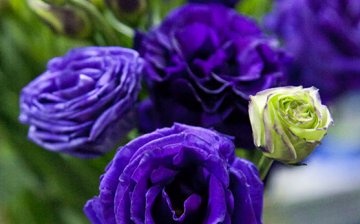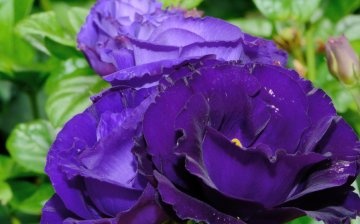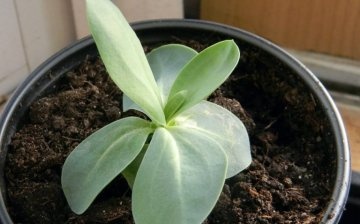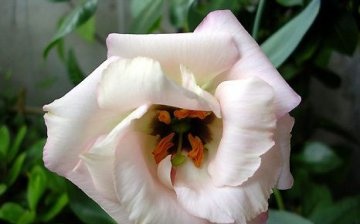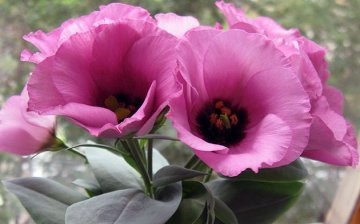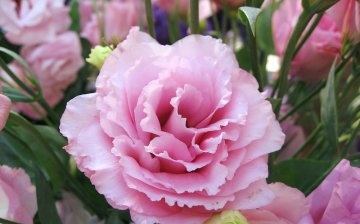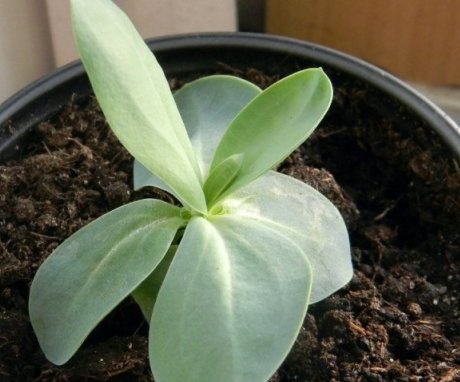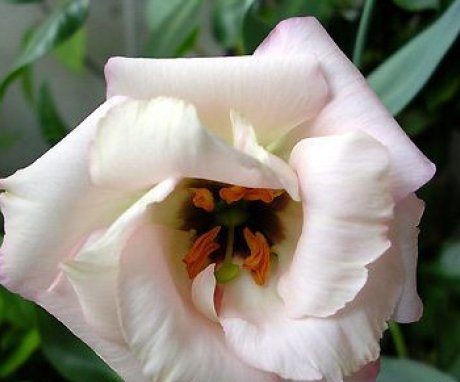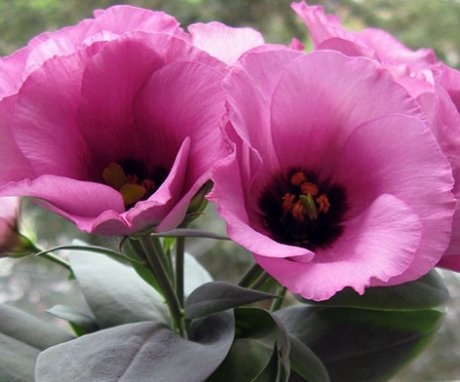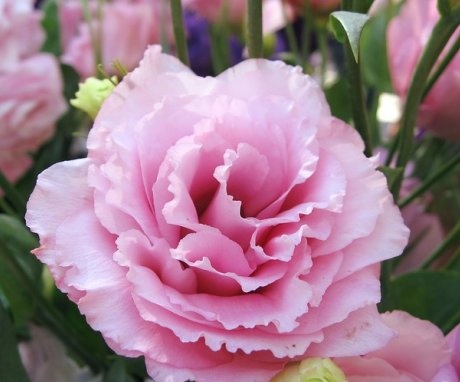Eustoma lisianthus - the most successful analogue of a rose
Elegant and graceful eustoma lisianthus will decorate not only balconies, loggias, but also gardens. This amazing plant is very similar to the queen of flowers - rose... However, he has no thorns, and the color is more interesting. Eustoma lisianthus is an overseas plant that comes from the warm and humid central part of America.
Florists consider her to be capricious, but the efforts spent on growing and caring pay off with a bit. Beautiful and large flowers appear, variegated or pale blue, pink or purple, red or white. The plant can be grown for the purpose of decorating loggias or balconies, for bouquets, garden landscaping. The unearthly beauty of the American attracts the gardener and makes him experiment. It is bred both in apartments and in open ground. This horticultural guide will help you learn about breeding methods, cultivation and care rules, determine the variety and type of eustoma. So you will already know what to buy and how to grow a beauty.
Content
- Description of eustoma lisianthus
- Popular varieties of eustoma
- Plant propagation methods
- Growing conditions
- Room care
- Outdoor care
- Diseases and pests
Description of eustoma lisianthus
Eustoma came to us from America, its warm and humid territory. It is an annual or perennial plant (depending on the variety) belonging to the gentian family. Another name is "Irish rose" or simply lisianthus. The flowers are very similar in structure to medium to large sized roses.
Description of eustoma:
- In diameter, they reach 10 cm or more, depending on the variety and species.
- Plant stems can reach a height of 80 cm, low varieties - 15 cm.
- Greens eustoma rare, only a few leaves on the stem. The color is gray-green with a waxy bloom.
- The shape of the leaves can be different from lanceolate to carved.
- The color of flowers varies from white to dark purple in the spectrum of red.
- In a garden culture, a type of eustoma is usually grown with lanceolate leaves and flowers of blue, blue and purple shades, large-flowered varieties.
In the distant 18th century, the plant was noticed due to its unusual appearance - it was very similar to rose... Botanists were interested in this striking similarity. They began to collect specimens of eustoma and send them to Europe for study and classification. So from America eustoma migrated to Europe. It became so popular that it quickly spread throughout the world. In Japan, it is called lisianthus, in England, the "rose of love" - a symbol of family well-being and happiness, in
The amazing flower received such recognition for the absence of thorns, beauty and long standing in vases with water, stability in bouquets and unusual decorative properties.
An interesting fact is that eustoma gained its popularity thanks to Japanese breeders. At one time, back in the 18th century, the Japanese, seeing this beauty, decided by all means to select as many varieties and species as possible. They more than succeeded. Despite the fact that eustoma came from America, it will always be associated with Japan.It was there that she was given life and the opportunity to grow everywhere. Now we can contemplate the unearthly beauty of yellow, orange and bright blue large flowers - the result of Japanese breeders.
The plant is quite capricious, but if the conditions are met cultivation and the rules of care, it will delight with its luxurious flowers and delicate aroma. Having decided to buy an eustoma, decide on the type and variety of the plant. Start from where it will be grown and why.
Popular varieties of eustoma
In nature, there are only 3 types of eustoma, they all come from North America. In horticulture, Russell's eustoma is grown - this is the only type of plant used for breeding at home and in open field conditions. Flower shops sell varietal and hybrid Lisianthus seeds. Depending on the method of cultivation and care, the plant can be bred as annual or perennial.
The most popular varieties of eustoma are:
- "Echo" - double flowers with a color from pale pink to yellow, bright blue. It was for the color that the growers fell in love with this variety.
- "Mermaid" - the color of this variety is rather gentle and not flashy, but you can also find a bright purple hue. Flowers are not double. Grown in pots at home.
- "Double White" - double flowers of various shades from white to blue. The flowers are large and very beautiful.
- "Kyoto" - here you can find a deep shade of burgundy. Looks very impressive, especially against the background lawn.
- "Aurora" - this variety can be grown in winter and by summer it will bloom. Double flowers with color from white to pale blue, pink.
- "Matador" is a small houseplant with rather large flowers. The color varies from white to pale beige. The edges of the petals are always richer - a blue border.
- "Heidi" - mainly grown in the garden. Often bred in large quantities for cutting and selling bouquets. The color is delicate pastel. Used to decorate wedding bouquets.
Whichever variety you choose, always keep in mind the fact that the plant loves moisture and warmth. He needs to create special conditions. Without this, the experiment on breeding eustoma will end in failure, it will die. Also consider the purpose eustoma - can be a variety for cutting or for growing in the room. All these parameters will help you choose the right variety.
Plant propagation methods
Propagate a curiosity with the help seed... Initially, they are purchased in stores, then they themselves collect seeds from an adult bush. Seeds are planted in winter - in January or February. The substrate for eustoma should contain turf, peat and sand. The ratio of parts is 2: 1: 1. Many experienced growers advise adding charcoal, but this condition is not necessary. Seeds are planted superficially, without deepening. The soil should be slightly moist, not soggy.
The container with seeds is covered with a glass lid or foil. Temperature for germination seed is 20 ° -23 °. When growing a plant from seed, always watch for condensation on the lid. When it appears, wipe off the glass or film. This is necessary so that the black leg does not appear. When the stem has already grown to a height of about 2 centimeters, transplant the seedlings into separate containers, for example, plastic cups. In this case, the lighting should be diffused, direct sunlight will destroy the plant instantly.
Having reached 15-20 cm in height, the eustoma can already be planted in open ground or in a permanent home flowerpot.
It is planted in May-June. Make sure there is no frost. Soil temperature should be 20 °. The soil can be preheated if you are not sure of its optimum temperature.
Another breeding method is grafting... However, he did not prove himself. Cuttings germinate poorly and often this venture does not end with anything. Germination conditions are the same as for seeds.The stalk is cut and germinated closer to winter.
Growing conditions
Based on the fact that eustoma is native to America, you can guess about its growing conditions:
- The air temperature should be quite high - 20 ° -25 °. However, it should not be exposed to the sun.
- Eustoma loves bright, but diffused light. Direct sunlight will destroy him. In the garden, the flower is planted in shaded areas, next to water sources.
- Humidity in both home and garden conditions should be high. Eustoma loves sprinkling and warmth. But if the room has dry air and high temperature (25 ° -30 °), it will quickly dry out and die. Therefore, it is very important to create tropical or subtropical conditions for it.
- The best option would be to grow in a flower greenhouse or greenhouse. There she will feel very comfortable - warm and humid, but not damp and there is no wind.
- The composition of the soil is a mixture of leafy earth, peat and sand. The ratio is 2: 1: 1. You can use another composition. For example, garden soil, perlite, sand, humus and lime. The ratio is 1: 1: 1: 1. Lime need not be added.
- It is advisable to impregnate the substrate with complex mineral fertilizers containing iron compounds. Try to avoid using fertilizers with a high nitrogen content. During the growing season, the plant is fed once every two weeks. For the winter, feeding is stopped and the temperature is lowered to 15 ° -20 °. However, she needs light in winter. For these purposes, use fluorescent lamps, special backlights. In our harsh winters, she will lack natural sunlight.
Having provided the eustoma with optimal growing conditions, the grower will very soon be able to admire the beauty of large and spectacular flowers.
Room care
Our houses and apartments often have very dry air and high temperatures. Therefore, the planted plant requires a certain leaving... The most important thing is watering eustoma:
- The earth lump must not be overdried, otherwise it will die.
- It is not recommended to overflow the soil - root system will rot.
- She needs a moderate watering, the soil should be moist, but not soggy.
- It is recommended to carry out a sprinkling procedure 1-2 a week with warm, settled water. She loves it very much.
If there is little light in the apartment, it is necessary to install fluorescent lamps or special lighting. Without proper diffuse lighting, the eustoma will die.
As it grows, it is necessary to remove faded flowers and dry stems, leaves.
This allows you to achieve multiple flowering during the growing season. Transplant carried out by the method of transshipment of an earthen lump together with a flower. The fact is that the root system of the eustoma is very fragile, it can be easily damaged during transplantation. Therefore, always remove the plant along with the soil and transplant it into a new substrate or into open ground with it. Compliance with all these rules of care will allow the grower to achieve abundant and juicy eustoma flowering.
Outdoor care
Care eustoma in the garden is not much different from the room. Monitor soil moisture and lighting. Plant it out of direct sunlight, wind, and moisture. Often the plant is identified in flowerpots and placed in the garden for decoration in summer. Next, the pot is brought into the house for the winter.
You can plant it in open ground, but in the fall you should transfer the eustoma to a pot for wintering at home.
This is exactly what many gardeners do. But it is better to grow the plant as an annual, so there will be no problems with transplant... Here everything is at the request of the grower. Top dressing brought in according to the same scheme (home conditions). In the garden, it is necessary to constantly monitor the condition of the plant. He may be overwhelmed pests and disease. In the open field, they appear much more often. If the plant is damaged, it is necessary to quickly take measures to combat the pest, otherwise it will die.
Diseases and pests
If the growing and care conditions are not followed, various diseases and peststhat will lead to death eustoma... Therefore, it is important to properly care for flowers and comply with the conditions for their maintenance. The most common plant pests are flour mites, thrips and whiteflies. They are fought with the use of insecticides. If white mold develops, use Triforin or fungicide... These pests and molds are considered the most common manifestations, so always keep an eye on the condition of the leaves and flowers.
Observing the rules of care - timely and moderate watering, feeding - will help to avoid the appearance of pests and diseases.
Prevention is always cheaper and more effective. You can add charcoal to the soil to prevent root rot or any other infection that forms in the soil. It is known to disinfect substrates well. Also, when growing a plant in a pot, do not forget about the drainage at the bottom of the plant. Use expanded clay or broken brick. Drainage will help prevent moisture buildup in the ground. Thus, the same root rot or other infection will not appear.
Eustoma is considered a rather capricious plant. But after understanding all the nuances cultivation and leaving, you can safely start breeding it. She will perfectly cope with the task of decorating balconies and loggias, flower bed and gardens, greenhouses and rooms. Very often it is placed in flowerpots and exposed to fresh air at the entrance to the house. It is also used to decorate flower beds and lawns... After reading the provided useful information, feel free to start breeding. Good luck!
More information can be found in the video.



